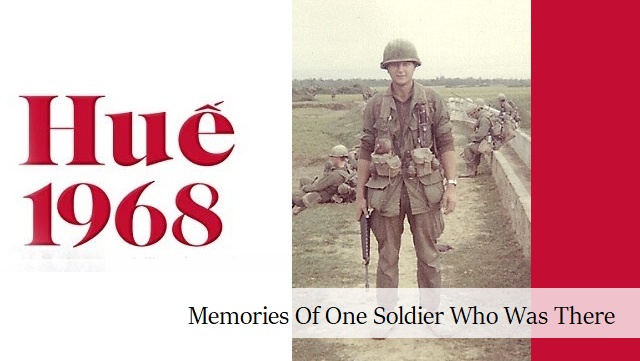The 1968 Tet Offensive and the Battle for the City of Huế — Memories of an Airborne Soldier
By Dr. Rich Swier

“Hue had become a city of the dead.” ― Mark Bowden, Hue 1968: A Turning Point of the American War in Vietnam
This story is dedicated to the men of the 2nd Battalion, 501st Airborne Infantry (2/501) who fought in the critical Battle for Hue. According to the US Army Center of Military History, “The fight for Hue turned into a slow, grinding campaign of attrition that lasted nearly a month before the enemy was finally defeated.”
I dedicate it to men like SSG Joe Ronnie Hooper and SSG Clifford C. Sims, Delta Company, 2/501, both of who were awarded the Congressional Medal of Honor, SSG Sims posthumously. SSG (later Captain) Hooper was second only to Audie Murphy in the number of awards and decorations with 37 compared to Murphy’s 38.
I dedicate it to the 2/501 airborne infantry Commanders: LTC Richard Tallman, Battalion Commander; Captains Reiss, Alpha Company, Nickels, Bravo Company, Denny Gillem, Charlie Company; 1st Lieutenant Cleo Hogan, Delta Company (the Delta Raiders) and 1st Lieutenant Buch, Recon Platoon leader. All were and still are true leaders of men.
Men like Captain Ken Crabtree, Commander, B Battery, 1st Battalion, 321st Field Artillery, who was my boss, mentor and personal friend. Lieutenant Colonel Crabtree would be killed on April 17, 1984 in a SWAPO guerilla bombing near the Angolan border, SW Africa. But that is another story for another time.
The Battle of Huế began on January 31st, 1968 and ended on March 2nd, 1968. I was there as a field artillery forward observer with the 2nd Battalion, 501st Infantry Airborne, 2nd Brigade of the 101st Airborne Division.
This is my story. I am writing this on the 54th anniversary of the Battle of Huế to honor those men I served with who gave the last full measure in defense of our nation and the Vietnamese people.
I am also writing this for those who were not there on the ground and those who have never heard of the Battle of Huế.
I do this because those who forget history are doomed to repeat it.
My Background
My father was born in Kyiv the capital of Ukraine. My grandfather graduated from Kyiv’s Bogomolets National Medical University school of medicine. My grandfather, grandmother and my father then moved to Moscow where my grandfather opened a medical practice. My grandfather was required to serve in the Czar’s army as a medical officer. After the November 1918 Bolshevik Revolution my grandparents and father had to flee Russia as the Bolsheviks were killing Czarist officers.
My father after the attack on Pearl Harbor on December 7th, 1941 joined the U.S. Army Air Corps. My father reached the rank of Staff Sergeant before the end of WWII. After the war he married my mother who bore three children. All boys of which I am the oldest.
After completing my college education I joined the U.S. Army and was commissioned a 2nd Lieutenant. My branch was one of the three combat arms the field artillery (13). The other two combat arms are infantry (11) and armor (12). I served 23-years in the U.S. Army and retired as a Lieutenant Colonel.
Now let’s look at my memories of the Battle of Huế.
The Battle of Huế
The Battle of Huế was also know as the “Siege of Huế.” It was a major military engagement in the Tết Offensive launched by the Communist North Vietnamese Army (NVA) in conjunction with their Communist allies in South Vietnam know as the Viet Cong (VC), made up of para-military gorilla units.
The Tết Offensive and the battle of Huế was considered a turning point in the war. It was a turning point on the ground in Vietnam were American forces with their allies and the South Vietnamese Army defeated the onslaught of the NVA and VC. Using American air supremacy and the professionalism of the combat units deployed in country the NVA and VC were totally defeated and in many cases decimated. U.S. and allied forces killed, destroyed and removed a large percentage of the NVA and VC forces. They were driven into the A Sầu Valley and from there fled South Vietnam back to Cambodia and Thailand.
However, on the streets of Washington, D.C. the anti-Vietnam War protestors convinced the U.S. government and the American people that all was lost.
We are now facing yet another war involving Russia, just as Russia was involved in the Vietnam War.
From July 1965 to December 1974, more than 6000 generals and officers and more than 4,500 soldiers from the former Soviet Union were sent to Vietnam as specialists. Small contingents of auxiliary forces from other states like Bulgaria and Cuba accompanied the Soviet specialists.
When the Tết Offensive began my infantry unit was located in was later known as Phu Bai combat base south of Huế where U.S. Army and U.S. Marine Corps combat units were stationed during and after the Tết Offensive.
On January 30-31, 1968, the base was hit by Vietcong mortar and rocket fire as part of the Tết Offensive. The base was used to support U.S. and Army of the Republic of Vietnam forces fighting in the Battle of Huế.
To this day I can remember the motor and rocket fire my unit took. An thus for me and my fellow airborne soldiers the Tết Offensive began.
I was in A Company when Tết Offensive began and we moved out with the objective of taking the Western wall of the Đại Nội Citadel located in ancient city of Huế which had already been overrun by the NVA and VC forces. My unit was attached to the 1st Calvary Division at that time.
The battles were many and long and hard fought by both sides. It took us over 30 days to reach our final objective the Western wall of the Đại Nội Citadel.
One thing is in my mind that will not ever be forgotten. As we approached the Đại Nội Citadel we came across the Huế Kim Long Church (click here to view the church) where many Christians were hiding from the Communist forces. We liberated the Church. Kim Long Church was established in the 17th centaury.
However, as we were speaking to the people who were liberated our unit encountered one sniper who kept firing upon us and those whom we had just liberated.
We eventually found and killed this sniper but not until the sniper shot my recon sergeant who was standing next to me. It was at that moment is said to myself “there but by the grace of God go I.”
When Hue was liberated we found over 7,600 civilians in shallow graves. Men, women and children with their hands tied with barbed wire behind their backs with gun shots in the back of the head by their NVA occupiers. Yet another Communist atrocity in South Vietnam that the American press refused to report on was this massacre.
I vividly recall that on the morning of February 26th a small boat pulled up to the A Company CP, located in a three story building along the Perfume River. The Perfume River (Sông Hương) is a river that crosses the city of Hue. In the autumn, flowers from orchards upriver from Hue fall into the water, giving the river a perfume-like aroma.
In the boat were a Vietnamese man and his very pregnant wife who was in labor. Our company medic was called into action and with the help of some hot water delivered a beautiful baby boy. I remember thinking that God is sending a message that life goes on even among all the carnage we had witnessed since January 31st.
The 2/501 left Hue in unit formation counting cadence all the airborne way. We lined up by company and marched out of the city to our next mission. Along the way young children would pull on our 101st Screaming Eagle shoulder patches, saying “Chicken die, chicken die” – so much for our liberating the Vietnamese from their NVA oppressors.
The road to hell made a turn for the 2/501 troopers to reopen QL – 1 or Highway 1, also known to the French as “the Street without Joy” and then due West into the A-Shau valley (the Valley of Death) and triple canopy jungle.
The Bottom Line
My infantry company was part of that bloody battle to drive the NVA and VC out of Hue and eventually out of South Vietnam. We accomplished both missions with minimum casualties on our side but massive casualties on their side.
The Tet Offensive and the Battle of Huế played an important role in weakening U.S. public support for the war in Vietnam because Walter Cronkite and the legacy media began telling the public that the Vietnam War was lost.
WATCH: 53 years ago Walter Cronkite calls for the U.S. to get out of Vietnam.
The reality on the ground was that Tet 1968 was a total and complete military disaster for the North Vietnamese Army (NVA) and the Viet Cong (VC). Once the Tet Offensive began it became clear that U.S. and allied forces, using their military advantage in capabilities and their air supremacy, killed or captured tens of thousands of enemy Communist forces.
Those of us who were on the ground during Tet 1968 saw us winning and winning big.
This was my first experience with fake news that lost us a war that we won.
I hope this never happens again, ever.
I believe that the United States should enter a war with one purpose in mind – win at all costs. Our mantra must be unconditional surrender of the enemy. We must demand the unconditional surrender of our enemies, just as we did in World War II.
Airborne, all the way.
©Dr. Rich Swier, LTC, U.S. Army (Ret.). All rights reserved.

This article is courtesy of DrRichSwier.com, an online community of citizen journalists, academics, subject matter experts, and activists to express the principles of limited government and personal liberty to the public, to policy makers, and to political activists. Please visit DrRichSwier.com for more great content.

